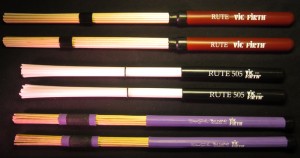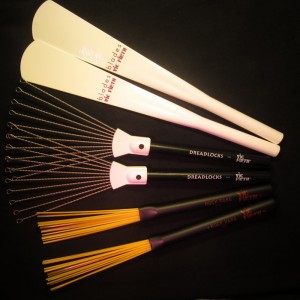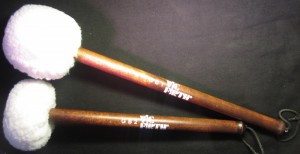Why do I play these sticks?
For many years, I have been playing and endorsing Vic Firth! Herby, I want to say thank you Vic Firth for he ongoing support over the years for myself as an artist as well as for Drummers Institute. I´ve been knowing Marco Soccoli – formerly Vic Firth – from my studies at Drummers Collective New York from Sam Ash! Marco was always helping and advising me in terms oft he choice of sticks. Thank you also to Joe Testa from Vic Firth Boston and Frank Rohe from Musik Meyer Germany!
Sticks
I am a Maple guy! Maple being a rather soft wood compared with hickory gives me the right feeling, a great balance and last not least the sound that I am looking for. Don´t forget that a sticks has a big influence on the sound of a cymbal or drum. For me personally hickory is a little to densed and slightly to heavy.
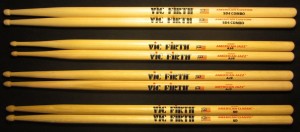 Many years, I had been playing the Bolero SD2, which has a round tip and therefore produces a very nice and clear cymbal sound – however maybe based on the fact, that I had to play rather soft at my theatre work and the Bolero SD2 is quite heavy, I changed to SD4 Combo, which I am still playing today. For most of my students, the SD4 Combo ist too light but in my opinion, drums is a loud instrument anyway and I don´t have to force it with heavy – let´s call is lazy – sticks. O.K – I am (god bless) not playing in a Speed Metal Band where I might need more power produced by bigger sticks. My ideal is to play easy with a good balance, save my wrists – especially when I am playing consistently over a long period of time-, have a good rebound and gain the power and attitude of a solite Rock song like ZZ Top but also the finesse of Jazz or Brazilian music. This is what the SD4 Combo is giving me! Because oft he round tip of the SD4 the stick produces a great sound and lasts for ever (presuming the right treetment), which is typical for Vic Firth!
Many years, I had been playing the Bolero SD2, which has a round tip and therefore produces a very nice and clear cymbal sound – however maybe based on the fact, that I had to play rather soft at my theatre work and the Bolero SD2 is quite heavy, I changed to SD4 Combo, which I am still playing today. For most of my students, the SD4 Combo ist too light but in my opinion, drums is a loud instrument anyway and I don´t have to force it with heavy – let´s call is lazy – sticks. O.K – I am (god bless) not playing in a Speed Metal Band where I might need more power produced by bigger sticks. My ideal is to play easy with a good balance, save my wrists – especially when I am playing consistently over a long period of time-, have a good rebound and gain the power and attitude of a solite Rock song like ZZ Top but also the finesse of Jazz or Brazilian music. This is what the SD4 Combo is giving me! Because oft he round tip of the SD4 the stick produces a great sound and lasts for ever (presuming the right treetment), which is typical for Vic Firth!
In times when I was playing up to eight shows a week and on my off-days in other bands or projects, I indeed didn´t use more than maximum one pair of sticks per month.
Inluenced by my teachers in New York, I was using the slightly longer 8D model which also is a little heavier than SD4 but more elegant than the usual 5A or 5B. It´s a great stick for Funk and Rock/Pop.
Lately I have been trying the even lighter stick model, that I love to use in the context of ECM cymbals sound played by a Jon Christensen or a Billy Higgins: it´s the AJ2 or – even better – the AJ6. They have a conical tip, are rather light and sound beautiful on my Flat Ride, my 21“ Dry Ride or on my Constantinoples! Especially in studio work those sticks sound very fine and defined.
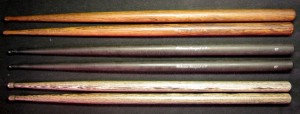 For orchesterwork or certain shows such as „Threepenny Opera“ or even „Cabaret“ when the orchestra is positioned between stage and audience, I use classical concert sticks made of ebony or rosewood. Those thicks have a thicker gripping section, are getting smaller to he tip and have a very small conical tip. They also work on timpanies when you have to play a very soft press roll right at the edge oft he head. Usually these concert sticks are quite expensive but they last very long if you use them correct (nothing for you Death Metal Band…). I use the concert sticks made by Rohema which are affordable and have a great quality: Rosewood 6Pa and Ebony 6A – both with natural oil finish.
For orchesterwork or certain shows such as „Threepenny Opera“ or even „Cabaret“ when the orchestra is positioned between stage and audience, I use classical concert sticks made of ebony or rosewood. Those thicks have a thicker gripping section, are getting smaller to he tip and have a very small conical tip. They also work on timpanies when you have to play a very soft press roll right at the edge oft he head. Usually these concert sticks are quite expensive but they last very long if you use them correct (nothing for you Death Metal Band…). I use the concert sticks made by Rohema which are affordable and have a great quality: Rosewood 6Pa and Ebony 6A – both with natural oil finish.
This brings up a subject of finishing. Some models or companies are using certain lacquer to finish their sticks – this finish can cause your hands to sweat which again leads to a tight grip. Obviously, this is quite a big problem in the long run and can cause cronical pain. The grip and the feeling of the stick has an immense influence to feel conformably at the drums and understand the stick as a natural extension of your arm. As long as you don´t suffer on allergy against lacquer or oil, I would rather change the stick model as opposed to use some sort of endorser-handcloves to provide palm grease.
Another subject would be nylon tip – which frankly speeking I don´t like, even though there is a signature model of he great Jack DeJohnette who plays nylon tip on ultra-dry-rides! By the way: this Jack DeJohnette Model is very long (a little like the 8D I was talking about) but not so heavy and has a green colour that can cause the problems mentioned above. Nylon – besides of the fact that they can fly around and hit your eyes –in my opinion sound artificial, hard and take away the warmth of a wooden sound. That´s why I also don´t like Carbon or any kind of artificial material for sticks.
It might sound esotheric, but we are breaking the flow of the elements earth (wood) and fire (metal) by using nylon. Historical drums and drumming is reflecting on our autonomic nervous system beeing the oldest form of communication and is definitely disconnected by plastic.
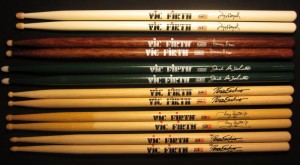 You should really try signature sticks – a good drum retailer or a music exibition can give you the chance to get hands on the sticks of your favourite drummer! Beeing a big Peter Erkine fan (he has a great cymbal sound), I recommend the Ride SPE with a conical tip and the SPE2 with a round tip. Both models are a little longer and heavier. For those who are looking for an alternative to the all time favorite Dave Weckl model, try the sticks of Harvey Mason which are a little heavier with a bigger round-tip. Of course, there is also the model of Jojo Mayer (white, a little heavy and short) or Buddy Rich (white, longer and conical), the green DeJohnette that I was talking about and many more. If you are looking for my main stickst – he SD4 Combos – but a little heavier: try the Tony Royster Jr. made of hickory – a little more densed and heavier.
You should really try signature sticks – a good drum retailer or a music exibition can give you the chance to get hands on the sticks of your favourite drummer! Beeing a big Peter Erkine fan (he has a great cymbal sound), I recommend the Ride SPE with a conical tip and the SPE2 with a round tip. Both models are a little longer and heavier. For those who are looking for an alternative to the all time favorite Dave Weckl model, try the sticks of Harvey Mason which are a little heavier with a bigger round-tip. Of course, there is also the model of Jojo Mayer (white, a little heavy and short) or Buddy Rich (white, longer and conical), the green DeJohnette that I was talking about and many more. If you are looking for my main stickst – he SD4 Combos – but a little heavier: try the Tony Royster Jr. made of hickory – a little more densed and heavier.
Brushes and Rutes
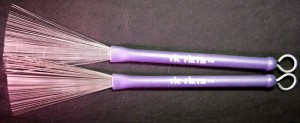 I am using brushes quite often and have focused on the Heritage Model. The rubber grip is very smooth and the fine metal wires produce a wonderful brush sound. Because of it´s flexibility you can play interesting effects in Samba or Solos. Sometimes I even use the Steve Gadd model with the snapped of tip which makes a good backbeat sound!
I am using brushes quite often and have focused on the Heritage Model. The rubber grip is very smooth and the fine metal wires produce a wonderful brush sound. Because of it´s flexibility you can play interesting effects in Samba or Solos. Sometimes I even use the Steve Gadd model with the snapped of tip which makes a good backbeat sound!
For rehearsals and some dinner gigs, 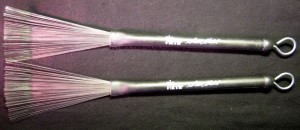 I am often using various rutes to protect ears and nerves! I usually use the 505´s for a solit but quiet back beat and normal Rutes or the Steve Smith Bamboo-11 for a crisp hi hat or ride sound. Or course, for some musical styles such as Samba and Bossa, Rutes just work perfect also in combination (right hand: Rutes, left hand: brushes). Frankly speaking, I hardly ever use special models like Blades, Dreadlocks or the Rute 404 but it is always exciting to try out new things!
I am often using various rutes to protect ears and nerves! I usually use the 505´s for a solit but quiet back beat and normal Rutes or the Steve Smith Bamboo-11 for a crisp hi hat or ride sound. Or course, for some musical styles such as Samba and Bossa, Rutes just work perfect also in combination (right hand: Rutes, left hand: brushes). Frankly speaking, I hardly ever use special models like Blades, Dreadlocks or the Rute 404 but it is always exciting to try out new things!
Mallets and More
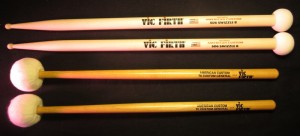 The model SD6 Swizzle B has been indispensable for me – it has a tigh felt on the one and a round tip on the other site. Especially in musical and theatre work where you have a lot of transitions from cymbal crescendo to march or even Big Band Swing, it is often nearly impossible to change sticks! So these twins are very helpfull! For a soft tom roll, imitating a timpani, I am using mallets with a soft flannel or felt tip such as the Adams TM3; those work fine for drummers who are used to a thicker grip that nearly feels like a drum stick. The TM3´s also work for timpani for soft and quiet passages. However for timpani’s I am using the models of Dave Morbey; they produce a great sound on the timpanies and are very high quality mallets. Mainly I am using 560FF, 530KK, HF300 and 540FF which all have different felt tips and hardness and therefore each produce
The model SD6 Swizzle B has been indispensable for me – it has a tigh felt on the one and a round tip on the other site. Especially in musical and theatre work where you have a lot of transitions from cymbal crescendo to march or even Big Band Swing, it is often nearly impossible to change sticks! So these twins are very helpfull! For a soft tom roll, imitating a timpani, I am using mallets with a soft flannel or felt tip such as the Adams TM3; those work fine for drummers who are used to a thicker grip that nearly feels like a drum stick. The TM3´s also work for timpani for soft and quiet passages. However for timpani’s I am using the models of Dave Morbey; they produce a great sound on the timpanies and are very high quality mallets. Mainly I am using 560FF, 530KK, HF300 and 540FF which all have different felt tips and hardness and therefore each produce 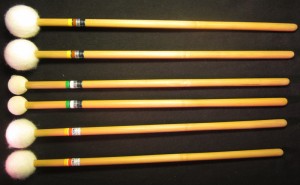 a different sound. Additionally I am using flannel mallets such as the Kaufmann 101 that sound very warm but with a good definition; For very special accents and strokes that should carry a crisp defined sound to the last row of the audience coming out of a muddy sounding orchester pit, I am using the Vic Firth American Custom T4 or even harder the T5 Wood model (those once are dangerous).
a different sound. Additionally I am using flannel mallets such as the Kaufmann 101 that sound very warm but with a good definition; For very special accents and strokes that should carry a crisp defined sound to the last row of the audience coming out of a muddy sounding orchester pit, I am using the Vic Firth American Custom T4 or even harder the T5 Wood model (those once are dangerous).
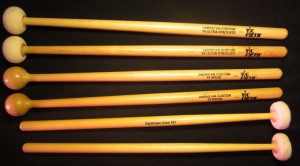 Even for glockenspiel / orchester bells there is a demand for different sounds, depending on the room, the music but also on the quality of he instrument. There are quite old and bad quality glockenspiels around which are terribly out of tune and therefore have to be covered by very soft sticks. My standard equipment for glockenspiel is a Vic Firth M142 with a soft plastic tip and I am also using metal heads such as M144/M146) or other plastic or wood heads. Since I am not realy a vibraphone or marimbaphone player, I rather leave the question of mallets to he experts.
Even for glockenspiel / orchester bells there is a demand for different sounds, depending on the room, the music but also on the quality of he instrument. There are quite old and bad quality glockenspiels around which are terribly out of tune and therefore have to be covered by very soft sticks. My standard equipment for glockenspiel is a Vic Firth M142 with a soft plastic tip and I am also using metal heads such as M144/M146) or other plastic or wood heads. Since I am not realy a vibraphone or marimbaphone player, I rather leave the question of mallets to he experts.
The choice oft he right stick or mallet is indeed a question of philosophy and belief and as individual as every single artist. However, quality always pays off!
So take your time when you try out new toys!
This is what I am looking for when I am choosing new sticks:
- Are the sticks matched ub straight? (roll them on an even surface)
- Do they have the same length? (put them straight up next to each other)
- How ist he texture and grain? (the less grain the better so they don´t break)
- Do they have the same weight? (they have to feel the same)
- Do they sound the same? (I click the stickst o each other and listen to an equal sound)
- Do they have the same density? (check out the difference: maple, hickory, etc.)
- How is he finish? (laquer or oil, feeling, grip)
- How is the tip? (round, conical, nylon, else)
- How is the sound on the cymbals? (very important!)
- Does the stick fit to me? (for example: there are Vic Firth kit sticks for children)

